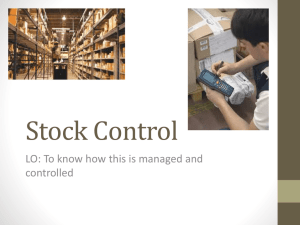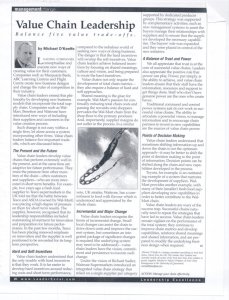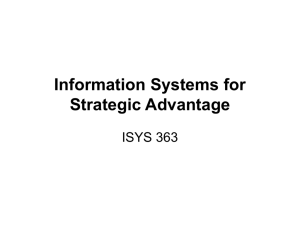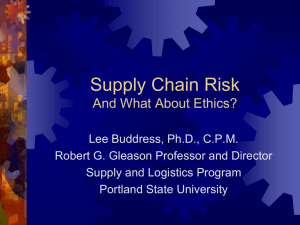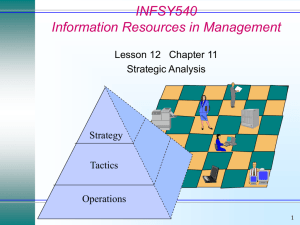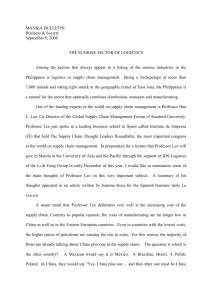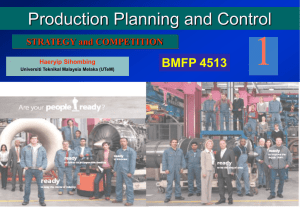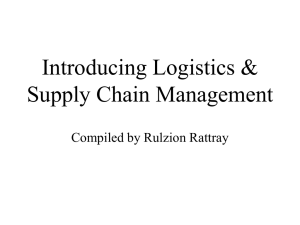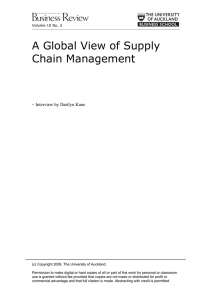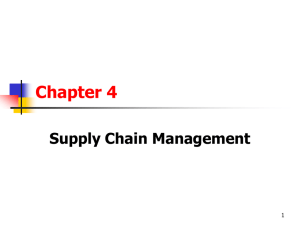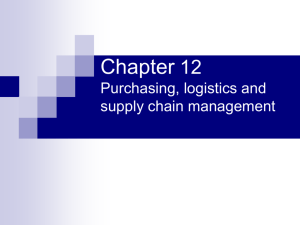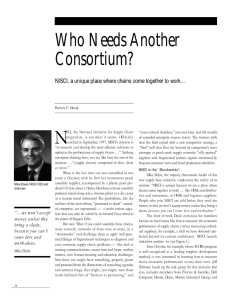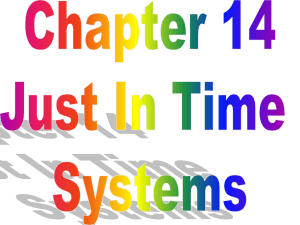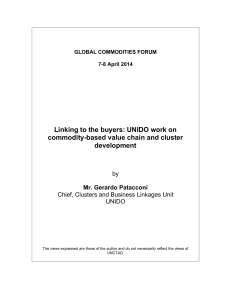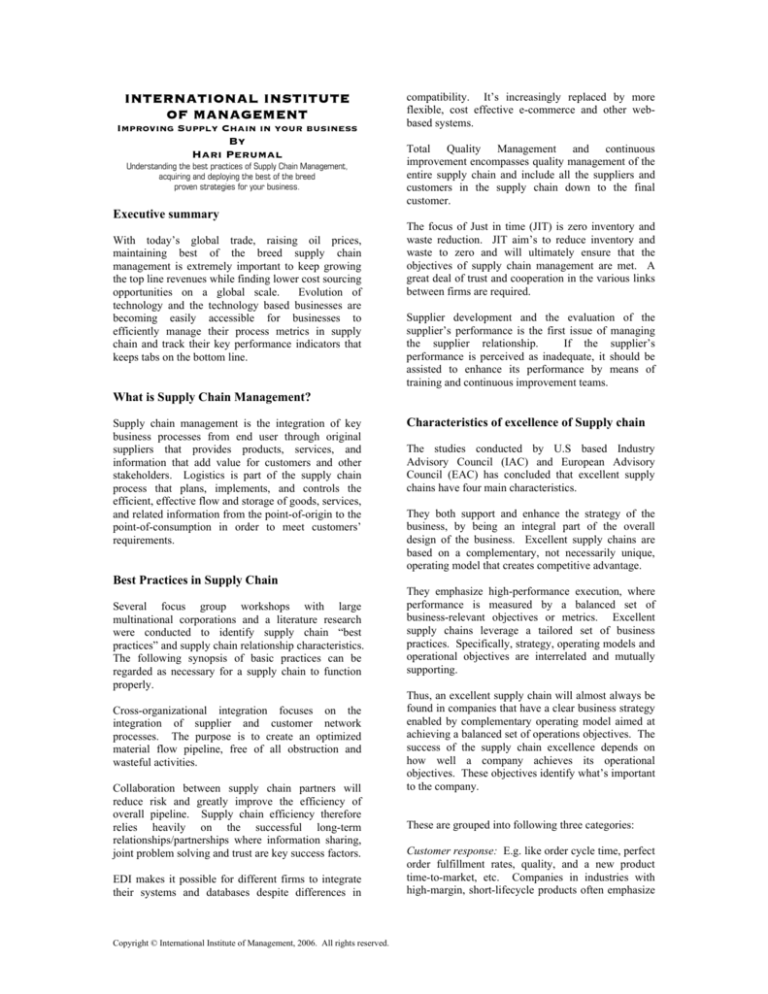
INTERNATIONAL INSTITUTE
OF MANAGEMENT
Improving Supply Chain in your business
By
Hari Perumal
Understanding the best practices of Supply Chain Management,
acquiring and deploying the best of the breed
proven strategies for your business.
Executive summary
With today’s global trade, raising oil prices,
maintaining best of the breed supply chain
management is extremely important to keep growing
the top line revenues while finding lower cost sourcing
opportunities on a global scale.
Evolution of
technology and the technology based businesses are
becoming easily accessible for businesses to
efficiently manage their process metrics in supply
chain and track their key performance indicators that
keeps tabs on the bottom line.
compatibility. It’s increasingly replaced by more
flexible, cost effective e-commerce and other webbased systems.
Total Quality Management and continuous
improvement encompasses quality management of the
entire supply chain and include all the suppliers and
customers in the supply chain down to the final
customer.
The focus of Just in time (JIT) is zero inventory and
waste reduction. JIT aim’s to reduce inventory and
waste to zero and will ultimately ensure that the
objectives of supply chain management are met. A
great deal of trust and cooperation in the various links
between firms are required.
Supplier development and the evaluation of the
supplier’s performance is the first issue of managing
the supplier relationship.
If the supplier’s
performance is perceived as inadequate, it should be
assisted to enhance its performance by means of
training and continuous improvement teams.
What is Supply Chain Management?
Supply chain management is the integration of key
business processes from end user through original
suppliers that provides products, services, and
information that add value for customers and other
stakeholders. Logistics is part of the supply chain
process that plans, implements, and controls the
efficient, effective flow and storage of goods, services,
and related information from the point-of-origin to the
point-of-consumption in order to meet customers’
requirements.
Best Practices in Supply Chain
Several focus group workshops with large
multinational corporations and a literature research
were conducted to identify supply chain “best
practices” and supply chain relationship characteristics.
The following synopsis of basic practices can be
regarded as necessary for a supply chain to function
properly.
Cross-organizational integration focuses on the
integration of supplier and customer network
processes. The purpose is to create an optimized
material flow pipeline, free of all obstruction and
wasteful activities.
Collaboration between supply chain partners will
reduce risk and greatly improve the efficiency of
overall pipeline. Supply chain efficiency therefore
relies heavily on the successful long-term
relationships/partnerships where information sharing,
joint problem solving and trust are key success factors.
EDI makes it possible for different firms to integrate
their systems and databases despite differences in
Copyright © International Institute of Management, 2006. All rights reserved.
Characteristics of excellence of Supply chain
The studies conducted by U.S based Industry
Advisory Council (IAC) and European Advisory
Council (EAC) has concluded that excellent supply
chains have four main characteristics.
They both support and enhance the strategy of the
business, by being an integral part of the overall
design of the business. Excellent supply chains are
based on a complementary, not necessarily unique,
operating model that creates competitive advantage.
They emphasize high-performance execution, where
performance is measured by a balanced set of
business-relevant objectives or metrics. Excellent
supply chains leverage a tailored set of business
practices. Specifically, strategy, operating models and
operational objectives are interrelated and mutually
supporting.
Thus, an excellent supply chain will almost always be
found in companies that have a clear business strategy
enabled by complementary operating model aimed at
achieving a balanced set of operations objectives. The
success of the supply chain excellence depends on
how well a company achieves its operational
objectives. These objectives identify what’s important
to the company.
These are grouped into following three categories:
Customer response: E.g. like order cycle time, perfect
order fulfillment rates, quality, and a new product
time-to-market, etc. Companies in industries with
high-margin, short-lifecycle products often emphasize
this set of objectives. These industries include
pharmaceuticals, fashion apparel, toys, and computers.
E.g. Best buy, Apple.
•
Efficiency objectives: These objectives are internal
measures that assess how well the company converts
inputs into output. E.g. include labor productivity,
labor content, supply-chain costs, wastage, etc. Cost
conscious companies such as food and beverage,
consumer electronics, non-fashion retail, and
industrial supplies often focus on these types of
metrics. E.g. Wal-mart, Dell.
•
Asset utilization objectives: This objective focuses on
how effectively the company is leveraging its assets
such as facilities, inventories and working capital.
Capital intensive companies like semiconductor
fabrications, petrochemicals, and commodity materials
makers, all try to make the most of their plant and
equipment with 24x7 operations. E.g. Amazon, IBM.
•
•
•
Leveraging value of existing supply solutions
•
Companies are realizing that it is cheaper
and more productive to re-evaluate what
they have bought, but not properly used,
rather than trying to get a new project going.
Understanding a company’s overall business
goals and its value proposition clearly is
essential to making the most of both past
and future technology investments.
Critical factor in making the right
investment decisions is to have an IT
roadmap for the enterprise which shows the
various pieces needed to support stated
business goals and how they all fit together.
To get more value from existing applications
fine-tune the existing business processes.
Easier integration – Enterprise application
vendors are responding to the pressure to
facilitate integration by breaking their
products into components. These can be
deployed,
extended
and
maintained
separately, using a common platform and a
standard component frameworks accessible
to third-party software developers
New Architecture – Some software
companies are employing this type of
Service Oriented Architecture (SOA) to
extend functionality in a similar way.
Because it is re-usable and modular, SOA
components do not create “the brittle, pointto-point infrastructure”. The idea is that
once the building blocks are in place, the
entire system can be build.
Mitigating Supply chain disruption
maintain corporate competitiveness
(1)
“Most of the supply-chain investments we are seeing
now have to do with trying to get more from current
applications, either by adding visibility and
performance-management tools, by trying to fill gaps
to get a more complete solution or by just making
information from existing tools more accessible to
users,” says Noha Tohamy, a principal analyst at
Forrester Research, Cambridge, Mass. To begin with,
companies generally are using only 25 percent to 50
percent of existing functionality, estimates Brad
Householder, Principal at PRTM Management
Consultants, Waltham, Mass.
Copyright © International Institute of Management, 2006. All rights reserved.
to
Improving the accuracy of demand forecast
•
Dynamic adjustments to reflect changes
in demand, lead times, transit time,
capacity, and transportation and
distribution routes, as well as events
outside the organization that could have
a material effect n forecasts.
(2) Integrate and synchronize planning and
execution
•
Can avoid majority of the problems by
better coordinating and integrating
planning and execution.
(3) Reduce the mean and variance of lead-time
•
Remove non value-added steps and
activities.
•
Improve the reliability and robustness
of manufacturing, administrative and
logistics processes.
•
Pay close attention to critical processes,
resources, and material.
•
Incorporate
dynamic
lead-time
considerations in planning and quoting
delivery times.
(4)
Collaborate and co-operate with supply
chain partners
•
Collaboration and co-operation among
supply chain partners will only happen
if there is trust among the parties,
upfront agreement on how to share the
benefits, and a willingness to change
existing mindsets. Once these elements
are in place, supply chain partners can
do joint decision making and problem
solving, as well as share information
about
strategies,
plans,
and
performance with each other.
(5) Invest in visibility
•
Identify and select leading or forward
looking indicators of supply chain
performance
(suppliers,
internal
operations, and customers).
•
Collect and analyze data on these
indicators.
•
Set benchmark levels for these
indicators.
•
Monitor these indicators against the
benchmark.
•
Communicate deviations from expected
performance to managers at the
appropriate levels on a real time basis.
•
Develop and implement processes for
dealing with deviations.
(6) Build flexibility in the supply chain
•
To enhance responsiveness, companies
need flexible strategies that match their
operations, such as product design,
sourcing,
manufacturing
and
postponement.
(7) Invest in technology
•
Web-based technologies can link
databases across supply chain partners
to provide visibility of inventory,
capacity, status of equipment, and
orders across the extended supply
chains.
•
Supply chain event management
systems have the ability to track critical
events and when these events do not
unfold as expected send out alerts and
messages
to
notify
appropriate
managers to take corrective actions.
•
RFID technology has the promise to
improve the accuracy of inventory
counts as well as provide real-time
information on the status of orders and
shipments in transit and what is being
purchased by customers.
gives competitive advantage by better business and
finance planning, better accountability and better
predictability.
An ERP with integrated PLM
capabilities can manage a product from concept to
production. It enables transfer of product information
and enterprise content between departments and
supply chain partners, optimizing the investments in
assets, resources and knowledge throughout the
product life cycle. Product data can be navigated
beyond the enterprise boundary between partners that
is critical for the success of the supply chain. This is
useful in conducting secure communication of project
related information between partners, contract
manufacturers and suppliers. This also helps in
complying with international regulations and patent
regimes.
Conclusion
Supply chain challenges are real in today’s
competitive environment. Evolution in technology
forces companies to re-think their supply chain
strategies. The effectiveness of the supply chain lies
in its ability to react to new demand situation and ever
changing needs of the customer. Supply chain
optimization is a continuous process and there is no
one solution for all supply chain optimization
problems. For effective supply chain optimization,
specific strategies to specific supply chain issues must
be deployed.
About the author
Hari Perumal has more than 15 years of global
manufacturing and IT experience. During this tenure
he has worked on several functions related to Sixsigma, GMP, lean manufacturing, Global supply chain
management, JIT, Kanban, process improvements and
information systems. Hari holds a B.S in Mechanical
Engineering from Madras University, M.S in
Computer Information Systems and MBA in Supply
Chain Management from California State University,
Hayward, CA.
References
James R. Stock & Douglas M. Lambert., Strategic
Logistics Management, McGraw-Hill Irwin 2001.
JA Badenhorst-Weiss, Ms I fourie, Mr JD Neil,
University of South Africa, The applications of supply
chain management best practices by small business
suppliers.
Extended ERP and SCM optimization
Global Logistics & Supply Chain Strategies (Jan 2005,
April 2005, May 2005).
The major advantage of extended ERP is that it
removes the integration hassles that are typically
associated with best of breed vendors. Extended ERP
Kaplan Robert and Norton David, The Balanced
Scorecard, Harvard Business School Press, Boston,
1996.
Copyright © International Institute of Management, 2006. All rights reserved.

